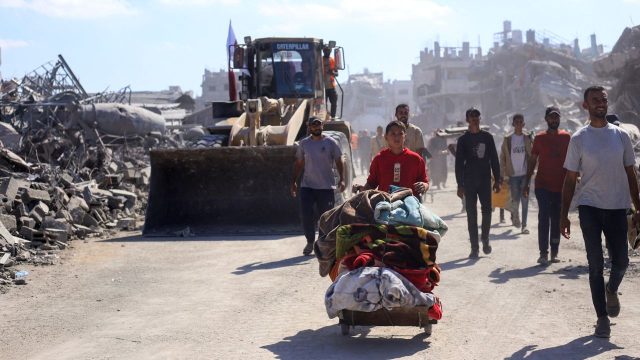
In the days after the ceasefire began on Friday, tens of thousands of displaced Gazans set out for their homes in the north of the Strip, many of them on foot and carrying little more than the clothes on their backs, said Nedal Hamdouna and Bel Trew in The Independent.
Flanking their route, on the coastal road, were the ashen remains of bombed-out buildings and piles of twisted metal, while “mangled skylines” loomed all around. “Your body shivers from the scale of the destruction,” said Mahmoud Al-Kafarneh, 37. Having been living for so long in a tent, he said he was looking forward to seeing familiar places; but would he find them?
Neighbourhoods levelled
Elsewhere, returning Gazans found only skeletal ruins where their homes had been – and nothing they recognised. Even if the ceasefire holds, Gazans face a very hard future, said Jim Armitage in The Times.
According to the latest UN data from satellite images, 92% of housing units in Gaza have been damaged or destroyed. As Israel stepped up its offensive in September, it levelled entire neighbourhoods in Gaza City. Gazans – 90% of whom are displaced – desperately need basic infrastructure. Work needs to start now, to provide water, sewerage, temporary shelters.
The cost of rebuilding
Next comes the task of clearing an estimated 50 million tonnes of rubble, so that makeshift clinics and schools can be set up in modular buildings. Then, once a reconstruction plan for Gaza has been agreed, the rebuilding can start. (This is expected to cost $53bn, and will require careful processes to be put in place, to stop the money being lost to corruption or funnelled to Hamas.)
But with unexploded ordnance mixed in with the rubble, human remains beneath it, and armed Hamas terrorists in their tunnels, even the first step in this process is likely to be fraught with difficulty and very slow.
Many Gazans are acutely malnourished, or sick, said The Guardian. They don’t have time on their side. Yet this week, it wasn’t clear even how much food aid was arriving. Aid agencies were told that 600 trucks a day would be allowed in, but by Wednesday, only a fraction of that number had got through.
Even the initial rubble clearing in Gaza is likely to be fraught with difficulty and very slow






